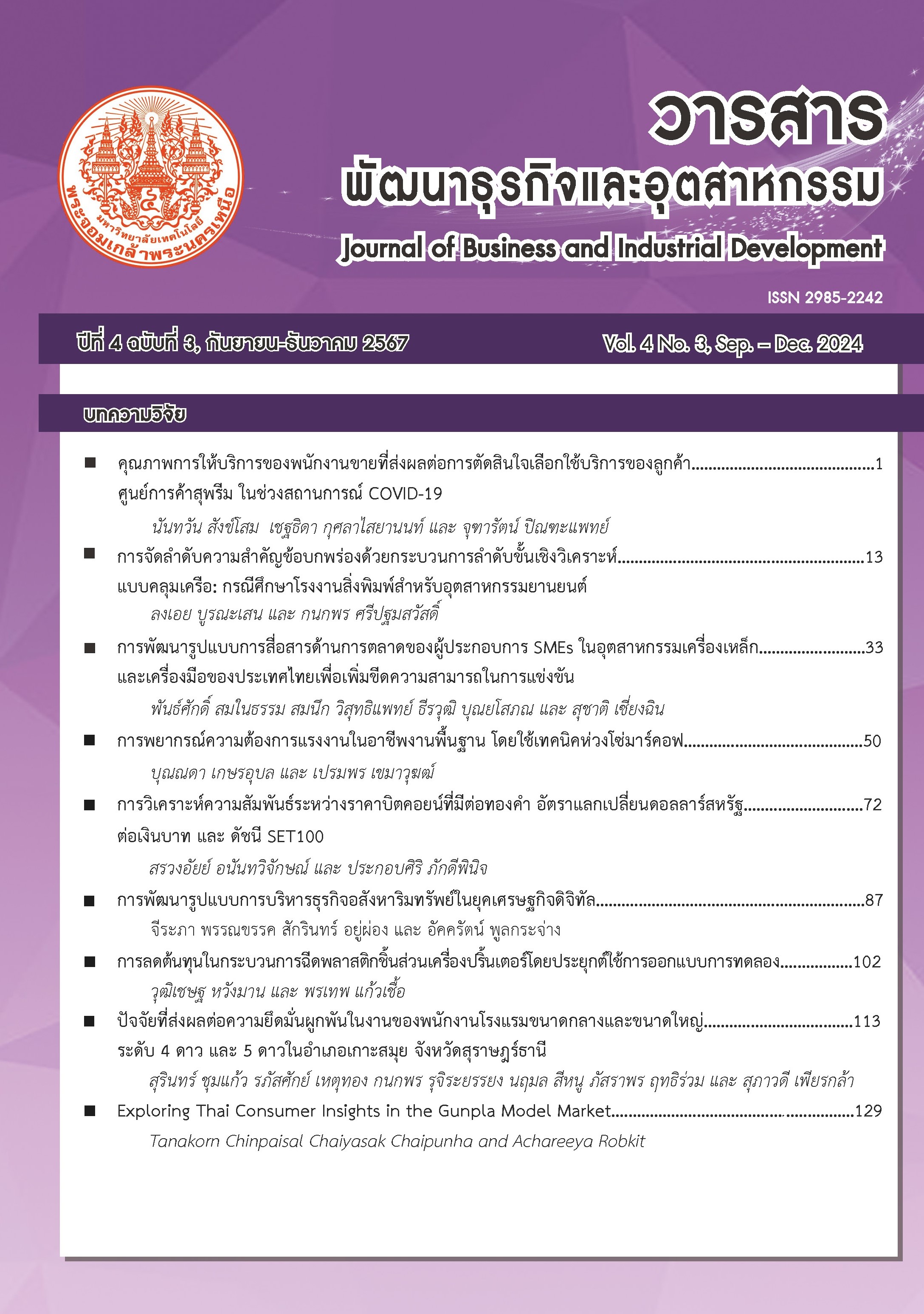Reduction Cost in The Plastic Injection Molding for Printer Machine Part by Appling Design of Experiment
Keywords:
reduction costs, reduction waste, plastic, design of experimentAbstract
This research aims to reduce costs at AAA Company Limited, a printer factory producing high-quality printers and scanners. Currently, the company face a problem of waste in the plastic injection molding process, an average of 3 per cent. From the analysis of the waste characteristics, it can divided into seven types: flashing, black dot, burn marks, collapse point, bent, cracks, and weld marks. There are four critical factors: mold age, mold structure, machine performance, and temperature for melting plastic. The researcher used the factors to design an experiment of 24 factorials for 16 experiments. Results from statistical packages showed that three factors affect waste generation, including 1. mold age, 2. machine performance, and 3. temperature for melting plastic. In addition, there are two pairs of correlated variables, including 1. mold ageing and machine performance, and 2. mold ageing and melting temperature. At the same time, the best results were a mold ageing of three years, a two-piece mold structure, a machine performance of 95 percent, and a melting temperature of 300 degrees Celsius. After improving the production process, 49,800 pieces were ordered in the first quarter of 2024, with 653 pieces of waste, a total waste value of 18,284 baht, or 1.3 percent. By comparing data, it was found that after improving the plastic injection process, the amount of waste could be reduced by 56.67 percent. The company can reduce waste costs from problems with black dot and flashing by 168,775 baht per year.
References
Chayarathi, C., Rakkran, S., & Plongmai, J. (2021). Design of Experiment to Reduce Waste in Plating Process. Journal of Science and Technology, 1(1), 29–38. (in Thai)
Homsri, P., & Kongtana, J. (2013). Design of Experiment (DOE) to Reduce Waste in Plastic Injection Process of Automotive Parts. Kasem Bundit Engineering Journal, 3(2), 73–95. (in Thai)
Preangprom, S., & Gerdkaew, K. (2022). Optimizing Storage Space and Order Picking in Warehouse Operations: A Case Study of an IT Product Distribution Company. Journal of Business and Industrial Development, 2(3), 17–33. (in Thai)
Pumyaem, K., Laotaweesub, W., & Cheevapruk, S. (2021). Management of Plastic Injection Processes: A Case Study of Electric Lamp Manufacturing. Research Journal Rajamangala University of Technology Thanyaburi, 20(1), 145–156. (in Thai)
Sriard, B., Sritong, C., Siriwoharn, T., & Klangphahol, K. (2021). Factors Influencing the Quality of Production in Thermoplastic Injection Molding Factories. Journal of Business, Economics and Communications, 16(1), 103–113. (in Thai)
Sengnongban, S., & Ngaoprasertwong, J. (2019). Cost Efficiency Analysis for Black Dot Defect in Plastic Injection Process by Six Sigma Approach. Engineering Journal Chiang Mai University, 26(2), 121–130. (in Thai)
Choobthaisong, S., & Kanchana, R. (2020). Reducing Defectives in Plastic Injection Process of Telephone Part by Design of Experiment. SWU Engineering Journal, 15(3), 17–31. (in Thai)
Preangprom, S., & Wongchai, R. (2023). Development of Warehouse Management Process: A Case Study of Medical Cosmetic Product Distribution Company Limited. Journal of Business and Industrial Development, 3(1), 12–26. (in Thai)
Sookmoy, A., Charoenprasit, S., & Tiantong, C. (2023). Improving Efficiency in the Process of Calibration of Measuring Instruments Within the Company: A Case Study of Alliance Laundry (Thailand) Company Limited. Journal of Business and Industrial Development, 3(2), 17–28. (in Thai)
Downloads
Published
How to Cite
Issue
Section
License
Copyright (c) 2024 Journal of Business and Industrial Development

This work is licensed under a Creative Commons Attribution-NonCommercial-NoDerivatives 4.0 International License.





